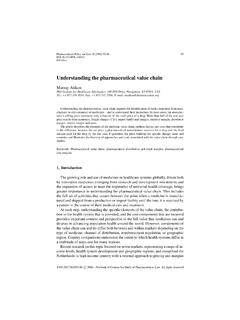Transcription of RESEARCH REPORT SEPTEMBER 2020 The Global Economic
1 RESEARCH REPORT . SEPTEMBER 2020. The Global Economic Impact of the Pharmaceutical Industry Prof. Dr. Dennis Ostwald Dr. Marcus Cramer Nora Albu Jasmin Tesch I. CONTENT. 1 EXECUTIVE SUMMARY. 2 INTRODUCTION. 3 DESCRIPTIVE ANALYSIS. 4 Economic IMPACT. 5 ANNEX. II. EXECUTIVE SUMMARY. Global GDP contribution million jobs of 532 billion dollars created The Global pharmaceutical The Global pharmaceutical industry directly contributed industry directly employed 532 billion dollars of over million highly gross value added to the productive persons in 2017. world's GDP in 2017. This This is equivalent to equals one percent of Global Switzerland's total GDP or about the GDP of the workforce.
2 Netherlands. Another 45 million jobs supported along the Global supply chain in particularly benefitting Asian and other developing countries due to structural differences in these regions The Global pharmaceutical industry procured direct inputs from other sectors worth over 800 billion dollars. This triggered effects in Global supply chains resulting in another 791 billion dollars of GDP. contribution and another 45 million supported jobs in the Global work force. Moreover, the private consumption triggered by directly and indirectly generated income resulted in an extra 515 billion dollars of GDP contribution and supported an extra 24.
3 Million jobs in the labor market. Through its Economic activity, the Global pharmaceutical industry contributes to the United Nations' Sustainable Development Goal 8: Promote Economic growth, employment and work for all. III. INTRODUCTION. In 2017, the Global pharmaceutical market was valued at 1,135 billion dollars. 1 The market has experienced ongoing growth over the last decade and is predicted to continue this trend. For the European Union, a growth rate of percent2 until 2022 is estimated, for North America percent3. The pharmaceutical industry is part of the Global health economy, which in 2014 was responsible for a contribution of 5,600 billion dollars to the Global GDP and supported 183.
4 Million people in the labor The pharmaceutical industry holds a share of eight percent in the Global health economy (in terms of contribution to GDP) and hence plays an important role in addressing modern challenges. Future large impacts are expected from the widely untapped emerging They offer vast growth potential made visible through an increase in per capita use of medicine and growing consumer income: medicine spending in these regions is expected to grow at five to eight percent through Therefore, the pharmaceutical industry has and will continue to have a significant Economic impact on the Global economy both in terms of the creation of contribution to GDP and employment.
5 The Global pharmaceutical industry's Economic impact is twofold. First, through the production of pharmaceutical products, the industry contributes directly to world GDP and supports a high number of employees. Second, through its Economic activity, the Global pharmaceutical industry supports additional value creation and employment through its dependence on Global supply chains. These indirect Economic effects, as well as the Economic effects induced by private consumption, are the Global pharmaceutical industry's Economic spillover effects. The present impact evaluation is based on industry level and utilizes the UN's International Standard Industrial Classification of All Economic Activities (ISIC) Rev.
6 4. In it, class C21. defines the pharmaceutical industry as Manufacture of basic pharmaceutical products and pharmaceutical preparations including basic pharmaceutical products, pharmaceutical preparations, medicinal chemical, botanical The year of compilation is 2017. 1. Statista, 2020. Revenue of the worldwide pharmaceutical market from 2001 to 2019 assembled from several statistics by IQVIA Institute for Human Data Science as published by Pharmaceutical Commerce. 2. Statista, 2019. Market growth forecast for certain pharmaceutical markets between 2017 and 2022. 3. Statista, 2019. Projected Global pharmaceutical market growth between 2017 and 2022, by region.
7 9. 4. WifOR calculations 5. Including: China, Brazil, India, Russia, Algeria, Argentina, Bangladesh, Chile, Colombia, Egypt, Indonesia, Kazakhstan, Mexico, Nigeria, Pakistan, Philippines, Poland, Saudi Arabia, South Africa, Turkey and Vietnam. 6. IQVIA Institute, 2019. The Global Use of Medicine in 2019 and Outlook to 2023. 7. United Nations, International Standard Industrial Classification of All Economic Activities, Revision 4, Statistical Papers Series M , 2008, New York. 4. DESCRIPTIVE ANALYSIS. SUPPLY AND DEMAND STRUCTURE. In 2017, the Global pharmaceutical industry had a total intermediate consumption from other sectors, goods and services consumed as inputs either transformed or used up by the production process8, of 809 billion dollars.
8 The top ten inputs for the Global pharmaceutical sector 's industrial production make up over two thirds of the total intermediate consumption (see: left column in table 1). The Global pharmaceutical industry's top supplier of goods or services from other sectors is the chemical sector with a share of percent, followed by the agricultural sector with a contribution of percent. Vice versa, the Global pharmaceutical industry's total intermediate output to other sectors, intermediate goods consumed by other sectors for their production of goods and services, equals 847 billion dollars in 2017. The top ten buyers of intermediate pharmaceutical goods consume almost 90 percent of overall intermediate outputs (see: right column in table 1).
9 The top buyer of pharmaceutical intermediate goods is the human health and social work activities sector ( hospital supplies and prescription drugs) with a share of percent, followed by percent used by the chemical sector . In addition to industrial buyers of pharmaceutical products, Global private household demand of pharmaceutical products, over the counter retail pharmacy sales, equals 310 billion dollars. In terms of capital goods, buildings and machines, intellectual capital and other investments by RESEARCH and development activities, the Global pharmaceutical industry's share is worth 24 billion dollars. Table 1: Top ten industrial suppliers of inputs to the pharmaceutical industry and top ten industrial buyers of intermediate goods from the pharmaceutical industry (in percent for 2017).
10 Source: WIOD, Eurostat, WifOR calculations. 8. United Nations Statistical Division: Glossary of the 1993 System of National Accounts ( ). 5. Economic IMPACT. IMPACT ANALYSIS: DIRECT, INDIRECT AND INDUCED EFFECTS. In addition to direct effects, which describe the immediate Economic effects directly generated by the Global pharmaceutical industry, the analysis encompasses indirect and induced Economic effects. Indirect effects are effects arising due to the input the industry demands from other Economic sectors. Order placements result in an increase of Economic activity at commissioned agents and their suppliers. This stimulus increases gross value added (GVA)and other Economic key figures along the supply chain.








